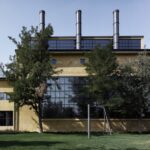The AGU Presidential Museum and Library, a project undertaken by EAA – Emre Arolat Architecture, stands as a testament to the transformation of historical industrial architecture into a vibrant contemporary space. Originally part of the Sumerbank Textile Factory in Kayseri, Turkey, these buildings, designed by Russian architect Ivan Nikolaev in the 1930s, symbolize Turkey’s industrialization and modernization during the Republican era.
A Legacy Reimagined: Restoration and Adaptation

Following the closure of the textile factory in 1999, the industrial complex, featuring remarkable examples of Russian Constructivist Architecture, gained recognition as a modern monument. In 2012, AGU, a newly established university, designated the complex as its main campus. Emre Arolat was commissioned by President Abdullah Gul to lead the architectural redesign and repurposing of the entire complex. Subsequently, in 2013, two buildings, the Power Station and Steam Plant, were earmarked for conversion into the Presidential Museum and Library, with EAA entrusted with the architectural execution.
Bridging Past and Present: Architectural Integration
Despite years of neglect, the buildings retained their voluminous spaces and authentic character, bearing witness to their industrial heritage. The restoration approach prioritized the preservation of original elements while seamlessly integrating contemporary interventions. Rather than emphasizing the contrast between different eras, the design aimed to create a harmonious architectural ensemble.

Preservation and Innovation: Material Selection and Design
Considerable effort was invested in preserving existing elements and addressing building services to ensure compliance with safety and accessibility standards. The material selection reflected a commitment to maintaining the buildings’ integrity. The interiors of the Power Station were reimagined as museum spaces, incorporating original features like ash pits into the exhibition experience. Similarly, the Steam Plant was transformed into a modern information center, with a distinctive three-story bookshelf structure complementing the existing spatial layout.

Immersive Experience: Exhibition Design and Cultural Integration
The exhibition design drew inspiration from Turkish values, traditions, and culture, creating a thematic visitor journey that resonates with the building’s architectural essence. By embracing the inherent volumes, textures, and natural light, the museum celebrates its heritage while offering a contemporary interpretation of historical narratives.
Inaugurated in 2016, the Abdullah Gül Presidential Museum and Library stands as a unique global landmark, exemplifying the successful adaptation of industrial heritage into a welcoming urban center.





























